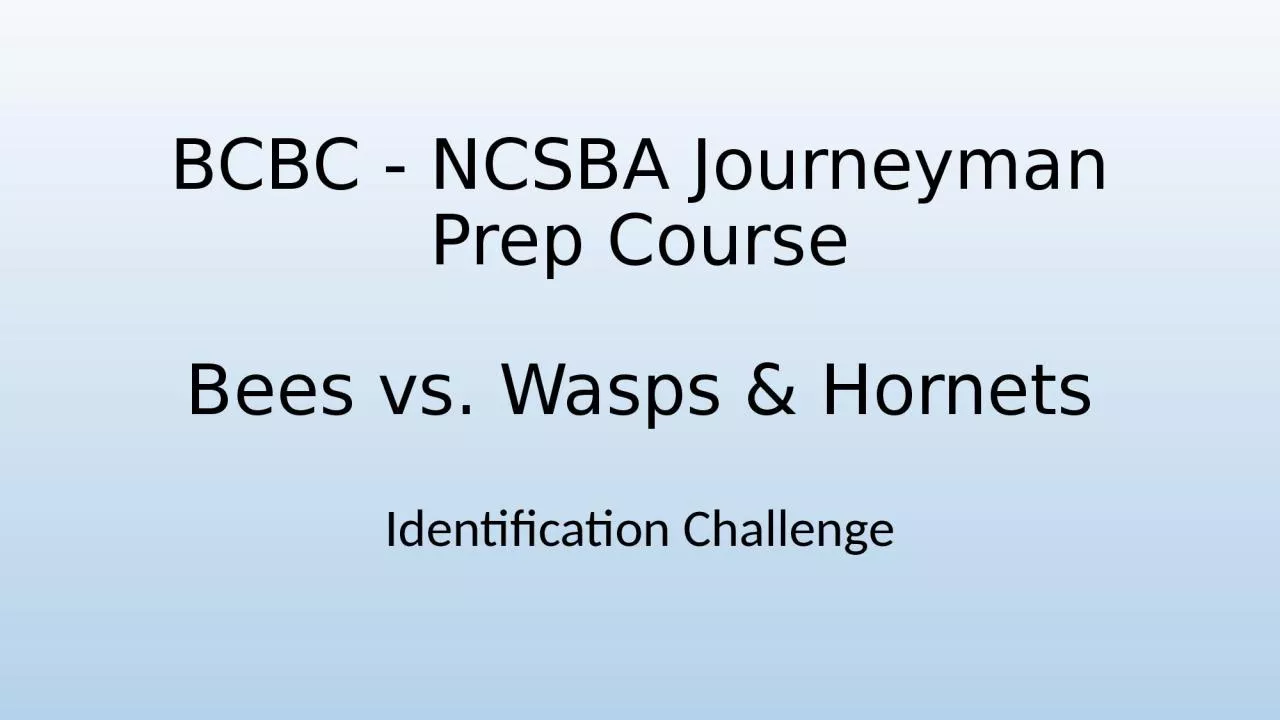

Bees vs Wasps amp Hornets Identification Challenge What is this Honey Bee What is this Yellow Jacket What is this Hover Fly mimic What is this Fly mimic What is this Drone Fly mimic ID: 927781
Download Presentation The PPT/PDF document "BCBC - NCSBA Journeyman Prep Course" is the property of its rightful owner. Permission is granted to download and print the materials on this web site for personal, non-commercial use only, and to display it on your personal computer provided you do not modify the materials and that you retain all copyright notices contained in the materials. By downloading content from our website, you accept the terms of this agreement.
Slide1
BCBC - NCSBA JourneymanPrep CourseBees vs. Wasps & Hornets
Identification Challenge
Slide2What is this?
Honey Bee
Slide3What is this?
Yellow Jacket
Slide4What is this?
Hover Fly - mimic
Slide5What is this?Fly - mimic
Slide6What is this?Drone Fly - mimic
Slide7What is this?
bee Fly - mimic
Slide8What is this?
Dirt Dauber (Mud Dauber) - wasp
Slide9What is this?
Yellow Jacket Mimic (Fly)
Slide10What is this?
Squash Bee
Slide11What is this?
BuffleHead
Mason Bee
Slide12What is this?Paper Wasp Eating a Grasshopper on Hop Clover
Slide13What is this?Bee Wolf (wasp)
Slide14What is this?Hornfaced Bee -
Osmia
Slide15Bees vs. Wasps - Differences
Slide16Honey Bee & Bumble Bee
Slide17Differences?
Note the difference in the body, size of legs, shape and location of antenna joint
Slide18Identification tipsBees
Two pairs of wings
Joined with a hook during flight
Long, jointed antenna
Very fuzzy/furry bodies
Tend to ‘dart’ from flower to flower
Flies
One pair of wings
Generally sleek body
Short antenna
Tend to Hover in front of flowers
Slide19Identification Tips
bees
Wasps/Hornets
Slide20Habitat
Slide21behaviors
Wasps
Kingdom - Animalia
Class – Insecta
Order - Hymenoptera
Suborder – Apocrita
Family –
Vespidae
(
A
wasp
is any
insect
of the order
Hymenoptera
and suborder
Apocrita
that is neither a
bee
nor an
ant
. This means that wasps are
paraphyletic
with respect to bees and ants, and that all three groups are descended from a common ancestor; the Apocrita form a
clade
.)
Wasps live in papery nests.
Minor Pollinator
Predator - Almost every pest insect species has at least one wasp species that preys upon it or parasitizes it
Prey -
Sweet plant matter, larvae are fed insects or consume their host. Varies among species, from nectar and fruit, to preyed or scavenged insects.
N
early all prey on or parasitize pest insects.
Sting – smooth - multiple times
Bees
Kingdom - Animalia
Class – Insecta
Order - Hymenoptera
Suborder - Apocrita
Phylum – Arthropoda
Family – Apidae
Subfamily – Apinae
Tribe - Apini
Genus - Apis
Hives -geometric wax hives.
Pollinator
Generally Non-aggressive, don't prey on other insects.
Less aggressive compared to wasps. Some bees can sting multiple times
Sting – once and die (honey bee)
Hornets
Kingdom - Animalia
Class – Insecta
Order - Hymenoptera
Suborder - Apocrita
Phylum - Arthropoda
Family –
Vespidae
Subfamily – Vespinae
Genus - Vespa
Nominal / non-Pollinator
Prey - Sweet plant matter, larvae are fed insects or consume their host.
Very aggressive, can sting multiple times; sting can be fatal to humans.
Sting – Smooth – Multiple times
Slide22Pollination
Wasps
very important pollinators.
Wasps are
insects
, in the same Order, Hymenoptera, as bees and ants.
Most familiar wasps belong to a group called the
Aculeata
. The word "
Aculeata
" refers to the defining feature of the group, the modification of their ovipositors into stingers, however not all members of
Aculeata
sting. In some members, the ovipositor is modified for a different function, such as laying eggs, or was entirely lost. This group is largely predatory or parasitic.
Wasps look like bees, but are generally not covered with fuzzy hairs. As a result, they are much less efficient in pollinating flowers, because pollen is less likely to stick to their bodies and to be moved from flower to flower
Slide23Pollination
Hornets
Poor pollinators (virtually non-existent)
Hornets generally eat live insects.
Some other large wasps are sometimes referred to as hornets such as the Bald-faced hornet which visits flowers, especially in late summer, and can be minor pollinators.
Slide24Bees
Bees are the champion pollinators!
In the United States, there are over 4,000 species of native bees.
Familiar bees visiting garden flowers are the colorful, fuzzy, yellow-and-black striped bumblebees, metallic-green sweat bees, squash bees, and imported honeybee.
These flower-seeking pollen magnets purposefully visit flowers to collect pollen and nectar for food for themselves and their young.
Energy Needs
All bees have very high-energy needs that must be met for their survival. Bees need key resources such as pollen and nectar from a variety of flowers. Many bees need water in addition to nectar.
Pollination
Slide25Megachilidae
The
Megachilidae
are a
cosmopolitan family
of (mostly) solitary
bees
whose pollen-carrying structure (called a
scopa
) is restricted to the ventral surface of the abdomen (rather than mostly or exclusively on the hind legs as in other bee families)
Megachilid genera are most commonly known as
mason bees
and
leafcutter bees
, reflecting the materials from which they build their nest cells (soil or leaves, respectively);
a few collect plant or animal hairs and fibers, and are called
carder bees
. All species feed on nectar and pollen, but a few are
cleptoparasites
(informally called "
cuckoo bees
"), feeding on pollen collected by other megachilid bees. Parasitic species do not possess
scopae
.
Megachilid bees are among the world's most efficient
pollinators
. The motion of Megachilidae in the reproductive structures of flowers is highly energetic and swimming-like. This vigorous agitation releases large amounts of
pollen
. While they are efficient as pollinators,
they are inefficient as foragers
; megachilids
require an average of ten times as many trips
to flowers to gather sufficient resources to provision a single brood cell as other types of bees.
A leaf-cutter bee showing abdominal scopa
Slide26What is this?Yellowfaced Bee – has internal Crop for carrying nectar and pollen
Slide27Linkswww.beespotter.orgwww.diffen.com
www.nativebeeology.com
www.insectidentification.org
www.fs.fed.us/wildflowers/pollinators/animals/bees.shtml